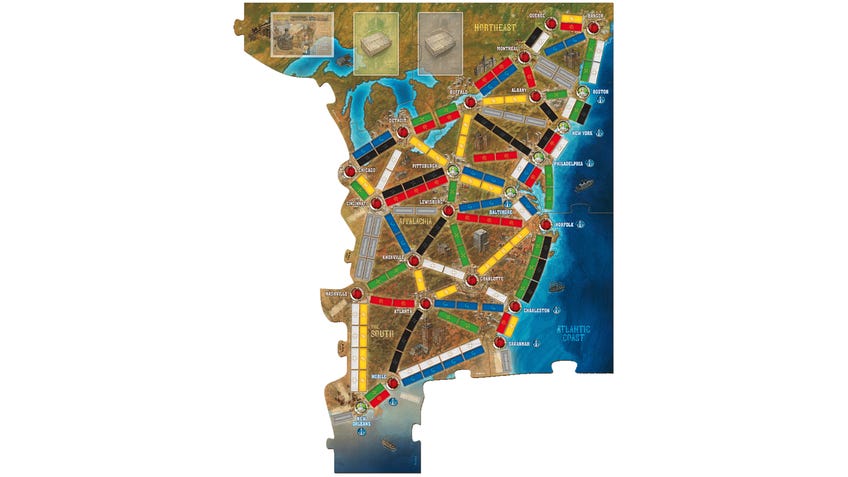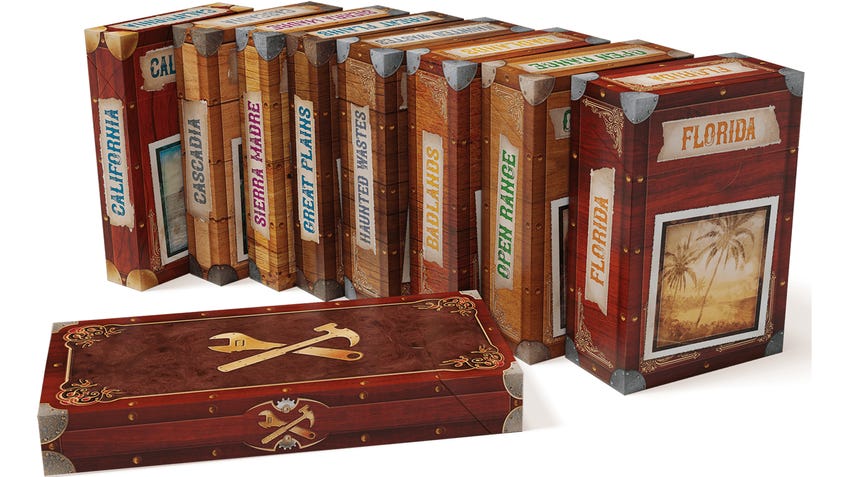Ticket to Ride Legacy: Legends of the West review - a gentle ride into legacy games with few unexpected turns
A spoiler-free verdict of Pandemic Legacy creators’ next evolving board game.
Rob Daviau and Matt Leacock set themselves a high bar to pass in Pandemic Legacy. One of the best board game trilogies of this century - arguably any century - the series reinvented Leacock’s 2008 co-op hit as an ambitious sprawling tale spanning humanity’s desperate fight against an unstoppable plague (eerily prescient for 2015), its efforts to survive and rebuild on a post-apocalyptic Earth, and a Cold War thriller prequel.
As well as painting an impressively gripping narrative on top of original Pandemic’s fairly blank starting canvas, Pandemic Legacy’s Season 1, 2 and 0 showcased Daviau’s knack for ingenious and playful legacy gameplay, as pioneered in the designer’s earlier reimagining of strategy classic Risk, by layering in new rules, forcing players to destroy and alter the physical pieces of the game, and having their success and failure leave a real, tangible impact on the board and its world.
Arriving close to a decade after Pandemic Legacy, Ticket to Ride Legacy: Legends of the West similarly takes the proven formula of a smash-hit game - one that likewise managed to break beyond hobbyist fans into mainstream popularity - and applies the legacy treatment, threading an ongoing story across 12 connected playthroughs that see players discovering new gameplay elements and surprises in the box as they go.
Daviau and Leacock’s spin on Alan R. Moon’s beloved train game pulls out of the station fairly slowly, offering a minor revision of the 2004 title in its first few sessions to help players accustom themselves to the new rules. As with Daviau’s update of Betrayal at House of the Hill in Betrayal Legacy, these small tweaks successfully serve to refine rather than replace.
The outcome is a game that gently improves on some more divisive aspects of the original from the off. Connecting to locations marked on the map as large cities allows the player to draw an extra card, helping to mitigate some of the game’s luck of the draw in pulling the train cards you need. You now start with a choice of up to four destination tickets for more flexibility in the routes you pursue - something that helps with the notably larger map in later sessions, too. Some routes have three parallel tracks that aren’t locked once one has been claimed, as with double routes in two and three-player lgames, avoiding the frustration of being completely shut out of a key location.
Additional gameplay elements are delicately layered over each other, bringing relatively small changes that nevertheless provide interesting reasons to consider pursuing certain routes over others or even forgoing chasing down your tickets entirely.
Otherwise, it’s largely Ticket to Ride as you remember it. Players draw train cards and play them in matching sets to claim multicoloured routes across the map, aiming to complete their destination tickets to earn money at the end of the game. That money replaces victory points, and is recorded on a bank slip for each game stored in a charming slotted ‘vault’ in each player’s individual storage box, to be totted up at the end of the entire campaign. The other half of your personal tuckbox is an ‘office’, allowing you to store and retrieve cards and other items throughout the campaign. It’s a small thing, but it feels satisfying to squirrel away your winnings and possessions in a private stash game after game.
While you get to write your name on the box to make it your own, the level of customisation is the bare minimum. It’s a major step back from the character creation of Pandemic Legacy; each company name and logo is already determined by the game, which have relatively little in-game effect and makes the lack of added personalisation feel a notable missed opportunity.

From there, in classic legacy fashion, the new reveals start arriving with each successive playthrough, pulling both from a deck of ‘postcards’ numbered like Choose Your Own Adventure book entries - each may have a secret objective for a player, new rules for the whole table or something else - and a set of tuckboxes that pack in various cards, rules, stickers and other physical components.
While the reveals are a big part of the draw of a legacy game - and we therefore won’t be spoiling anything here - there’s nothing throughout the course of Legends of the West’s campaign that really left our table of players reeling in the same way as Daviau’s previous twists and turns. Additional gameplay elements are delicately layered over each other, bringing relatively small changes that nevertheless provide interesting reasons to consider pursuing certain routes over others or even forgoing chasing down your tickets entirely in favour of other paths to victory.
In some respects, this is a relief. Around the midpoint of the campaign and through to its finale, the number of interlocked gameplay cogs turning means that simply claiming a route or drawing a card might trigger three or four (if not more) separate rules and events, with both rules that affect the whole table and those specific to each player found on their collected postcards. Even so, games rarely drag on thanks to the steady trackbed laid by vanilla Ticket to Ride’s simple choice of drawing cards or claiming a route on your turn, avoiding slamming the brakes on even as the game piles on rule after rule. Some rules are also smartly phased out after a certain time, leaving the game feeling more like a satisfying journey through different ideas than crawling to its finish line under the weight of an overloaded engine.

Without giving away any specifics, each new rule slots in neatly with Legends of the West’s historical arc both mechanically and thematically, as the game traces the proliferation of railroads and the increasing presence of rail-centric business over three decades in the latter half of the 19th century.
The expansion of railroads into the west of North America serves as inspiration for the game’s most intriguing idea. Legends of the West offers a lightly open-world feel to its rolling-out of new rules, as the winner of each session has the opportunity to add a new region to the jigsaw-like map board at the end of games. (You’ll need a decently-sized table: the board gets big.) Each region typically comes with a brand new gameplay concept, but there’s no fixed order in which you unlock them, beyond having to move logically through areas to get to locations farther afield - you might choose to explore the entire north first, head along the south border or simply travel coast-to-coast.
A trip through - and away from - history
Legends of the West’s rulebook includes a note from co-designer Rob Daviau about the decision to set the legacy game during the second half of the 19th century, acknowledging that the board game explicitly doesn’t look to grapple with the devastating impact that American expansion had on the Native American tribes dispossessed and killed as railroads were built, as well as the labourers who were exploited, mistreated and injured while working on the lines. Rather than be included in a half-measure way, those aspects are entirely excised.
“While designing this experience, we found no way to include these elements within the lighter theme of the game,” Daviau writes. “These omissions are not meant to conceal or gloss over these events and we encourage you to read more about the real-world history of American railroad expansion.”
Being neither American, Native American nor a history or railroad expert, I am not the best person to judge whether Legends of the West’s handling of its real-world elements is appropriate in a historical sense. While it makes sense that trying to depict and explore those aspects would make this a very different game, the question remains of whether the game needed to be set in this exact place and time. After all, its opening chapter takes place the very same year that the American Civil War came to an end. Could it really not have seen players rebuild railroads across a post-apocalyptic Earth, as in Pandemic Legacy? Or even a fantasy realm?
Daviau’s note states that “this game leverages those [familiar tropes] to tell a story of a world inspired by ours”. Legends of the West does steer away from reality in some of its later chapters, but the backdrop of its historical setting remains present throughout in its places, events and ideas. I appreciate Daviau addressing the decision upfront and encouraging players to seek out the reality behind the game’s inspirations. Still, even after finishing the campaign, I’m not entirely convinced that the experience of Legends of the West is so reliant on its setting that it couldn’t have avoided this discussion entirely - rather than being forced to say something about saying nothing.
The player-directed exploration helps to make up for the generally less world-changing legacy reveals, during a campaign that often feels closer to a lighter Choose Your Own Adventure spin on Ticket to Ride than something with the shocking rug-pulls and experimental ambition of legacy games’ standouts. Cementing that sense of a less roller-coaster-like experience is that the game seems comfortable giving away some of its own surprises, with postcards unlocked earlier in the campaign occasionally referencing rules and mechanics yet to appear - leaving players somewhat in the know about what to to expect, even if the specifics remain under wraps unlike later. (In some cases, it can be exciting to see what’s coming; in others, a little frustrating to be sat on a useless ability for multiple hours.)
Combined with the player-driven exploration of the board is a separate overarching plot that progresses with each successive chapter. While it’s effective enough as a way of threading the other more disparate parts of the legacy experience together with a more focused storyline, I found that the central plot struggled to tighten its grip on me. That’s a shame, as there was such promise at the beginning. It introduces the darker thread of a murdered rail baron as a way of explaining why the players’ companies have the chance to move in on the territory, but never really establishes pursuing its main villain as much more than a side note in the players’ ambitions. Its ultimate payoff towards the game’s conclusion ended up feeling fairly underwhelming as a result, becoming a little lost among the litany of other gameplay distractions.
While the story feels a little more perfunctory and the gameplay reveals don’t feel as revolutionary as I hoped for from the first major legacy adaptation of a popular board game in some time, there’s no denying that I had an entertaining time throughout Ticket to Ride Legacy. What it lacks in those big dramatic moments, it makes up for with a constant train-car buffet of tasty bitesize ideas. Some are more filling than others, but there’s never a sour taste left.
The gentler ride makes it feel like a legacy game designed for those taking their first trip into the inventive genre, rather than the next must-play for fans awaiting their next group fixation after Pandemic Legacy.
In many ways, despite its arrival a decade after the format emerged, the gentler ride makes it feel like a legacy game designed for those taking their first trip into the inventive genre, rather than the next must-play for fans awaiting their next group fixation after Pandemic Legacy, Betrayal Legacy or Daviau’s ambitious-to-a-fault (and underappreciated) SeaFall - which, for all its flaws, demonstrated the designer’s groundbreaking approach to legacy gaming at its peak.
It is worth acknowledging here that Legends of the West's MSRP is $120, a good deal more than those other legacy games can be found for today, and 12 playthroughs is all you’ll get. With no win/lose outcome like the cooperative Pandemic Legacy leading to repeated attempts at certain chapters, you’re paying around $10 for each campaign session here. That’s not where that investment ends, though; there is a post-campaign version of the game that allows you to replay it endlessly, albeit with a significant number of the gameplay elements removed. (There is also a way to play the campaign at least twice again - using fresh copies - while retaining some of the mystery.)

If you’re new to legacy games, a Ticket to Ride fan or are looking for a more easygoing campaign game to break out with friends for a few months, Legends of the West will be more than worth the price of taking its trip. After all, it’s still a Ticket to Ride game and still offers up enough freshness in each game to make its 12 playthroughs an engaging ride. My group found ourselves playing multiple chapters in a row every night, interested in seeing where we’d go next and what might emerge from the latest tuckbox. Even if that anticipation was never quite fully matched by the game’s reveals, returning to the game was always a joy.
Yet Ticket to Ride Legacy also feels very safe for a genre that has excelled in driving the idea of what board games can be forward into new territories. For all the ground covered by players during Legends of the West’s sprawling campaign, the game itself seems content to stick to the rails.
Ticket to Ride Legacy: Legends of the West will be released on November 3rd. This review was based on a retail copy of Ticket to Ride Legacy provided by the publisher.


